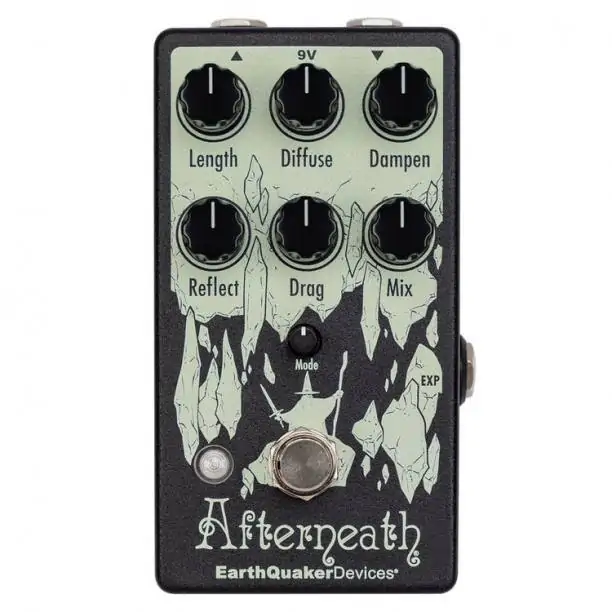The EarthQuaker Devices Afterneath is an otherworldly reverberation machine that uses a cluster of short delays to create wild and cavernous reverberations with scattered, rhythmic reflections, offering fine-grained control over the reverberations it produces. More than a simple emulator of acoustic reverb, this pedal lets the player design the character of the reverb he or she wants.
It features six controls (aside from the footswitch). Mix and Length are pretty familiar — they control the mix between the dry/wet signal and the decay of the reverb, respectively. Where it gets interesting are the oh so close to alliteratively named Diffuse, Dampen, Drag and Reflect.
V3, released at NAMM 2020, introduces CV In compatibility, tails/no tails operation, but most importantly a new mini Mode Knob offering 9 unique modes, including the original’s sound (all the way to the left).
Here’s the list of modes, which change the way the Drag control functions. The LED will change colors indicating which mode you are in.
1. Unquantized: Smooth, unquantized response over the operating range
2. Unquantized with Slew: Smooth, unquantized response over the entire operating range, but with a musical slew that is reminiscent of turning the varispeed knob on a vintage British tape delay. The “Drag” will lag behind the knob or cv changes, but then quickly catch up.
3. Unquantized Volt/Octave: Smooth and unquantized, yet scaled to align with the 1v/octave curve to allow melodic modulation of audio in the buffer, or control the frequency of self-oscillation like a voltage controlled oscillator.
4. Chromatic Scale: Quantized 1v/octave to the chromatic scale
5. Minor Scale: Quantized 1v/octave to the minor scale
6. Major Scale (Lydian): Quantized 1v/octave to the major scale (Lydian)
7. Pentatonic Scale: Quantized 1v/octave to the pentatonic scale
8. Octaves & Fifths: Quantized 1v/octave to omit all but octaves and fifths
9. Octaves: Quantized 1v/octave to omit all but octaves
Knob Functions
Diffuse “adjusts the spread” of the reverb. In the demo video, it swings between a replication of the dry signal that retains a similar attack, and more of a flat drone. Drag seems to be like the “time” control you might find on a delay pedal. It extends or quickens the time between reverberations. Dampen is a type of tone shaper, according to the EarthQuaker Devices site, sweeping between bright and dark. Reflect controls reverb regeneration, or how many copies of copies will propagate. When turned up it can self-modulate and probably take the pedal into boomy echo-storm territory.
With the Afterneath EarthQuaker Devices seems to have fully cracked the Pandora’s box of impressionistic possibilities given by digital reverb . I can’t wait to get my hands on one and get weird! – Nathan Smith
The Afterneath sounds a lot like it looks – a wizard bursting forth from ethereal cave and ready for the ambient battle. You are the wizard – or sorceress, if you prefer – and the cave is your instrument’s signal, vast, expansive, and magical. Do you go inside? Roll a D20 to proceed!
Once inside, a reflection of light from an unknown source catches your eye, and you notice a bizarre sheen on the walls of the cave. You timidly inch closer to the walls of the cave. Placing your hand gently on the cavern wall, you feel the rock move. The cave is alive! Alarmed, you emit a loud gasp, which reverberates throughout the subterranean landscape. Upon further listening, it appears as though the reverberations of your voice are in fact a swarm of short digital delays which may be used to create wild and cavernous reverbs, or scattered, short, rhythmic delays with bizarre characteristics.
Take a moment to consider your Intelligence and Wisdom scores, as well as your spell inventory before proceeding further. You have seven spells at your disposal…
Will you cast “Length,” which controls the decay length of the reverb?
What about “Diffuse,” which adjusts the spread of the reverb? With your wand (or just the knob) turned counterclockwise, the reverb is sharper with more attack, resulting in a stuttering sputter of individual early reflections. Clockwise casts a washy, more ambient-sounding hex.Overwhelmed by fear, you hastily cast “Dampen!” As you shout the incantation, you notice that a counterclockwise variation of this spell results in brighter tones, while as you rotate your wand clockwise; you hear darker tones with a mellower top-end. It’s almost as if your magic changes the hardness of the cavern walls, and thus the tonal characteristics of the reverb!
Elsewhere in your book of magic is “Drag,” which separates the individual digital delay lines, literally dragging them through the very fabric of time and space towards an unknown event horizon from which they may never return. Clockwise “Drag” positions will gather the delay lines close together for a more reverb-like effect. Turn the “Drag” counterclockwise, and the delay lines will begin to pull apart for a scattered ping-pong delay effect.























